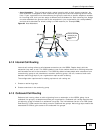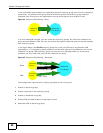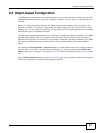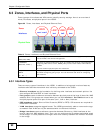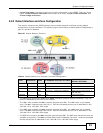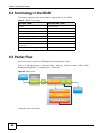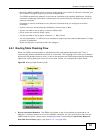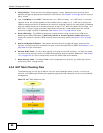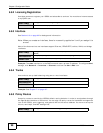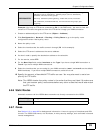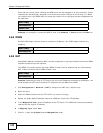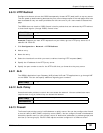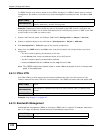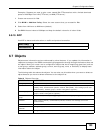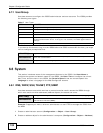
Chapter 6 Configuration Basics
ISG50 User’s Guide
97
1 SNAT defined in the policy routes.
2 1 to 1 SNAT (including Many 1 to 1) is also included in the NAT table.
3 NAT loopback is now included in the NAT table instead of requiring a separate policy route.
4 SNAT is also now performed by default and included in the NAT table.
6.6 Other Features Configuration Overview
This section provides information about configuring the main features in the ISG50. The features
are listed in the same sequence as the menu item(s) in the Web Configurator. Each feature
description is organized as shown below.
6.6.1 Feature
This provides a brief description. See the appropriate chapter(s) in this User’s Guide for more
information about any feature.
Example: This provides a simple example to show you how to configure this feature. The example
is usually based on the network topology in Figure 67 on page 93.
Note: PREQUISITES or WHERE USED does not appear if there are no prerequisites or
references in other features to this one. For example, no other features reference
DDNS entries, so there is no WHERE USED entry.
MENU ITEM(S)
This shows you the sequence of menu items and tabs you should click to find the main
screen(s) for this feature. See the web help or the related User’s Guide chapter for
information about each screen.
PREREQUISITES
These are other features you should configure before you configure the main screen(s)
for this feature.
If you did not configure one of the prerequisites first, you can often select an option to
create a new object. After you create the object you return to the main screen to finish
configuring the feature.
You may not have to configure everything in the list of prerequisites. For example, you
do not have to create a schedule for a policy route unless time is one of the criterion.
WHERE USED
There are two uses for this.
These are other features you should usually configure or check right after you configure
the main screen(s) for this feature. For example, you should usually create a policy
route for a VPN tunnel.
You have to delete the references to this feature before you can delete any settings. For
example, you have to delete (or modify) all the policy routes that refer to a VPN tunnel
before you can delete the VPN tunnel.



